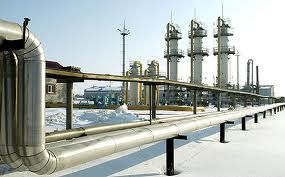
The second quarter was brutal to North American natural gas producers. The NYMEX natural gas price averaged $2.22 per MMBtu, dropping further from the already sub-economic $2.74 per MMBtu average in Q1 and sending a powerful economic pain signal to the operators to reduce output. One would expect a sharp supply response to follow immediately. Indeed, the gas-directed rig count has continued to shrink at a fast clip, dry gas budgets have been cut across the industry almost to the bone, and many operators have implemented sizeable production shut-ins and/or postponed well completions. Several prominent CEOs, including Aubrey McClendon of Chesapeake (CHK) and Michael Watford of Ultra Petroleum (UPL) have warned that a sharp supply decline is imminent.
Surprisingly, little production retrenchment has been seen so far in the national natural gas numbers. The EIA-914 data show production essentially flat during the months of November 2011 through May 2012 (latest available) as illustrated in the chart below.
During those seven months, the industry continued to overproduce at a rate of approximately 2.3 Bcf/d, as storage surplus relative to its 5-year average grew from 200 Bcf at the end of October last year to 700 Bcf at the end of May this year. The warm winter is often blamed for the big portion of the glut, but I would argue the impact was more than offset by the incremental coal displacement as a result of the sub-economic natural gas prices.
One could attribute the continued resilience of the production volumes to the time lag between the price signal and the operators' response. Some analysts forecast a tangible reduction in volumes in the following months' statistical releases (the June EIA-914 figures will be available at the end of this month). I would argue that any significant declines are highly unlikely. When analyzing the budget trends and operating forecasts from over a dozen large U.S. natural gas producers, I arrive at the conclusion that the production volume may show continued resilience and, as a result, natural gas prices may remain vulnerable to sharp corrections throughout the rest of this year.
Despite the weak price environment, many operators are planning to increase their production during the second half:
• Devon Energy (DVN): +85 MMcf/d (+4%) in H2 from Q2
• Southwestern Energy (SWN): +(65-120) MMcf/d (+(4-8)%) in H2 from Q2
• Chesapeake Energy : +400 MMcf/d (+12%) to peak in H2 from Q2
• Cabot Oil & Gas (COG): +170 MMcf/d (+27%) in H2 from Q2 (I use high end of guidance)
• Range Resources (RRC): +45 MMcf/d (+8%) in Q3 from Q2 (and similar growth in Q4)
• Quicksilver Resouces (KWK): +(20-30) MMcf/d (+(6-10)%) in Q3 from Q2
• WPX Energy (WPX): approximately flat in Q3 from Q2 (my estimate)
• Encana (ECA): +(150-200) MMcf/d (+10-12%) in H2 from Q2 as curtailments are reversed (my estimate)
Several other independents have guided to production declines during the second half:
• Anadarko Resources (APC): -(130-155) MMcf/d (-(5-6)%) in Q3 from Q2
• Ultra Petroleum : -(35-55) MMcf/d (-(5-8)%) in Q3 from Q2
• EOG Resouces (EOG): -(45-70) MMcf/d (-(4-7%)) in Q3 from Q2
• QEP Resources (QEP): -30 MMcf/d (-4%) in Q3 from Q2 (my estimate)
Adding production increments across this admittedly incomplete sample, I arrive at the aggregate production growth that these independents are planning for the second half of the year.
Clearly, Oil Majors remain the big uncertainty in the overall U.S. supply equation. In Q2 2012, the four companies, ExxonMobil (XOM), BP (BP), Chevron (CVX) and Royal Dutch Shell (RDS.A) accounted for almost 8 Bcf/d of net production (the operated production figure is even higher). As a group, the four will likely continue to post moderate production declines in the next two quarters, however those declines may not be sufficient to offset the net increase from the independents (I will discuss the gas production outlook for the Majors in my follow-up note).
This analysis illustrates why not all the industry insiders share Aubrey McClendon's and Michael Watford's conviction that the U.S. natural gas production will drop off rapidly. Here is a view expressed last Friday by Southwestern Energy's CEO Steve Mueller:
"…We expect that the gas is going to be slow in turning over. I think it's flattened out right now and will stay fairly flat for the next several months. The reason we believe it's going to stay flat for the next several months is that every area, while rigs are dropping, everyone's doing the same thing we're doing to the Fayetteville Shale - they're drilling their best wells. And so I think it's going to follow not the same shape, but the same general concept that happened to Barnett, where as the rigs dropped off, the Barnett production held fairly stubborn, flat for a while and now is starting to turn over. …And that's why I say, we're comfortable for the next several months that you're not going to see a strong turnover in production, but when and how, that's the real question."
Source: Seeking Alpha
We use cookies to improve your experience. By continuing to use our site, you accept our Cookies, Privacy Policy,Terms and Conditions. Close X